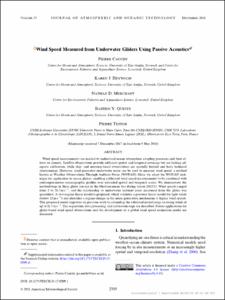| dc.contributor.author | Cauchy, Pierre | |
| dc.contributor.author | Heywood, Karen J. | |
| dc.contributor.author | Merchant, Nathan D. | |
| dc.contributor.author | Queste, Bastien Y. | |
| dc.contributor.author | Testor, Pierre | |
| dc.coverage.spatial | Mediterranean Sea | en_US |
| dc.date.accessioned | 2023-06-02T15:54:00Z | |
| dc.date.available | 2023-06-02T15:54:00Z | |
| dc.date.issued | 2018 | |
| dc.identifier.citation | Cauchy, P., Heywood, K. J., Merchant, N. D., Queste, B. Y. and Testor, P. (2018) Wind Speed Measured from Underwater Gliders Using Passive Acoustics. Journal of Atmospheric and Oceanic Technology, 35, pp.2305–2321. DOI: https://doi.org/10.1175/JTECH-D-17-0209.1 | en_US |
| dc.identifier.uri | https://repository.oceanbestpractices.org/handle/11329/2245 | |
| dc.description.abstract | Wind speed measurements are needed to understand ocean–atmosphere coupling processes and their effects on climate. Satellite observations provide sufficient spatial and temporal coverage but are lacking adequate calibration, while ship- and mooring-based observations are spatially limited and have technical shortcomings. However, wind-generated underwater noise can be used to measure wind speed, a method known as Weather Observations Through Ambient Noise (WOTAN). Here, we adapt the WOTAN technique for application to ocean gliders, enabling calibrated wind speed measurements to be combined with contemporaneous oceanographic profiles over extended spatial and temporal scales. We demonstrate the methodology in three glider surveys in the Mediterranean Sea during winter 2012/13. Wind speeds ranged from 2 to 21.5 m s21, and the relationship to underwater ambient noise measured from the glider was quantified. A two-regime linear model is proposed, which validates a previous linear model for light winds (below 12 m s21) and identifies a regime change in the noise generation mechanism at higher wind speeds. This proposed model improves on previous work by extending the validated model range to strong winds of up to 21.5 m s21. The acquisition, data processing, and calibration steps are described. Future applications for glider-based wind speed observations and the development of a global wind speed estimation model are discussed. | en_US |
| dc.language.iso | en | en_US |
| dc.rights | Attribution 4.0 International | * |
| dc.rights.uri | http://creativecommons.org/licenses/by/4.0/ | * |
| dc.subject.other | Sea surface wind speed | en_US |
| dc.subject.other | WOTAN | en_US |
| dc.subject.other | Underwater gliders | en_US |
| dc.subject.other | Underwater noise | en_US |
| dc.subject.other | Wind generated underwater noise | en_US |
| dc.title | Wind Speed Measured from Underwater Gliders Using Passive Acoustics. | en_US |
| dc.type | Journal Contribution | en_US |
| dc.description.refereed | Refereed | en_US |
| dc.format.pagerange | pp.2305–2321 | en_US |
| dc.identifier.doi | https://doi.org/10.1175/JTECH-D-17-0209.1 | |
| dc.subject.parameterDiscipline | Meteorology | en_US |
| dc.subject.dmProcesses | Data processing | en_US |
| dc.bibliographicCitation.title | Journal of Atmospheric and Oceanic Technology | en_US |
| dc.bibliographicCitation.volume | 35 | en_US |
| dc.description.sdg | 14.a | en_US |
| dc.description.maturitylevel | Pilot or Demonstrated | en_US |
| dc.description.adoption | Novel (no adoption outside originators) | en_US |
| dc.description.sensors | Passive acoustic monitoring (PAM) | en_US |
| dc.description.sensors | Acousonde B003A-HF datalogger | en_US |
| dc.description.methodologyType | Method | en_US |
| obps.contact.contactname | Pierre Cauchy | |
| obps.contact.contactemail | p.cauchy@uea.ac.uk | |
| obps.resourceurl.publisher | https://journals.ametsoc.org/view/journals/atot/35/12/jtech-d-17-0209.1.xml | |
 Repository of community practices in Ocean Research, Applications and Data/Information Management
Repository of community practices in Ocean Research, Applications and Data/Information Management

